Oenanthe pimpinelloides
Oenanthe pimpinelloides is a species of flowering plant in the family Apiaceae known by the common name corky-fruited water-dropwort. It is a plant of damp or dry grassland and more ruderal tall herb communities.[1]
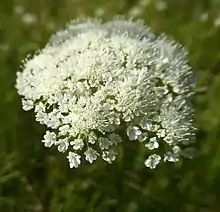
| Oenanthe pimpinelloides | |
|---|---|
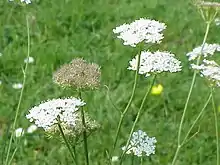 | |
| Scientific classification | |
| Kingdom: | Plantae |
| Clade: | Tracheophytes |
| Clade: | Angiosperms |
| Clade: | Eudicots |
| Clade: | Asterids |
| Order: | Apiales |
| Family: | Apiaceae |
| Genus: | Oenanthe |
| Species: | O. pimpinelloides |
| Binomial name | |
| Oenanthe pimpinelloides | |
Description
Corky-fruited water-dropwort is a hairless, upright perennial with a solid, strongly grooved stem measuring up to 100 cm in height and 0.5 cm in diameter. The roots contain ovoid tubers a short distance from the base of the stem. The lanceolate to ovate lower leaves are twice pinnate with broad, toothed, cuneate segments 55 mm long and have a petiole up to 10 cm long. The petiole may exude sparse white latex when pierced.[2] The upper leaves are once- or twice-pinnate, and the blade is at least the same length as the petiole; the linear, entire lobes are 10–30 mm long.[3]
The main umbels each have of 6–15 smooth rays, 1-2 cm long, which thicken after flowering. Below these rays is a whorl of up to 5 small linear-lanceolate bracts. The peduncles of the secondary umbels (umbellules) are longer than the rays and also thicken after flowering, producing fruiting heads that are distinctively flat-topped. Each umblellule is subtended by 12-20 small, linear bracteoles.
It flowers from June to August in the UK.[4] The terminal umbels have both male-only and bisexual flowers, while the lateral umbels produce only male flowers. The non-fruiting male-only flowers are on longer stalks (pedicels) than the bisexual ones. Each tiny flower has 5 pointed, green sepals and 5 white petals, the outermost of which are slightly larger (a phenomenon known as "radiating"). There are 5 stamens, and 2 styles which project from the bulbous centre of the flower (the stylopodium). The stylopodium is the organ which secretes nectar onto its surface, attracting unspecialised species of pollinating insect, such as flies. The fruit is a schizocarp: a hard capsule that splits into two one-seeded mericarps as it matures. Each schizocarp is 3-3.5 mm long, with a prominent ridge on each mericarp. Like the rays and the peduncles, the individual pedicels also thicken after flowering.[3] [5]
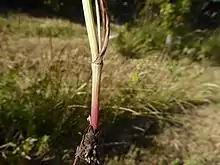
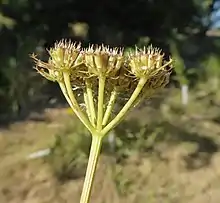
Identification
Unlike other species in the genus, Oenanthe pimpinelloides has ovoid to globose root tubers (‘potatoes’) that are situated some distance from the base of the stem. Narrow-leaved water-dropwort may also have tubers of this shape (the only other species displaying such a character), but in contrast to O. pimpinelloides, these are held close to the base of the plant.[6] However, on the grounds of conservation and wildlife law, the plant should not be uprooted to examine this character for identification purposes; different morphological features and habitat context should be looked at instead.[7]
Amongst the British species, corky-fruited water-dropwort is distinctive because it tends to grow in dry habitats and has flat-topped umbels. The bracts distinguish it from narrow-leaved water-dropwort, which has similarly fine foliage.[3][5]
O. pimpinelloides has been frequently confused with the very similar O. incrassans in southeast Europe, which is sometimes treated as a subspecies.[8][9]
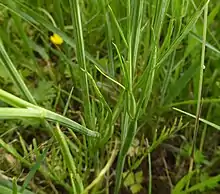
Taxonomy and nomenclature
The scientific name for corky-fruited water-dropwort was coined by Peter Artedi, who developed the modern binomial classification system, and defined the species on the basis of its involucral characters.[10] It was published after Artedi's death by Linnaeus in Species Plantarum, in 1753, and that name still stands, although numerous synonyms have been proposed over the years, including Oenanthe globosa Georgi (1800), Oenanthe graminifolia Gaudin (1828), Oenanthe anatolica K. Koch (1846), and Phellandrium mathioli Bubani (1899). A full list can be found in the Synonymic Checklists of the Plants of the World.[11]
The following subspecies are currently recognised: O. pimpinelloides subsp. incrassans (Bory & Chaub.) Strid (2012), which occurs only in Greece;[12] O. pimpinelloides subsp. callosa (Salzm. ex DC.) Maire, which is found in Morocco and Spain;[13] and O. pimpinelloides subsp. pimpinelloides, which accounts for all other populations but is rarely recorded.[14]
There are no reported hybrids.[15]
Its chromosome number is 2n = 22.[3]
The generic name Oenanthe, which comes from the Ancient Greek οίνος, "wine" and άνθος, "flower", was used in ancient times for certain Mediterranean plants and later adopted to describe this genus. The Latin specific epithet “pimpinelloides” means “resembling Pimpinella”, another genus in the same family (Apiaceae). The "dropwort" part of the common name is a reference to the tubers produced amongst the roots of this and certain other species in the genus.[16]
Habitat and ecology
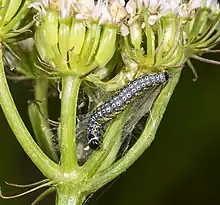
This is a plant of damp to dry grassland, hay meadows, old pastures and roadsides. Being more resistant to water stress than its congeners,[17] it is the only water-dropwort that grows in dry lowland habitats in some parts of its natural range.[1] Although it is usually described as a grassland plant, its habitat is often somewhat ruderal and tending towards scrub. This is perhaps why it is not listed in any of the vegetation communities of the National Vegetation Classification in Britain.[18] In Sardinia, it has been described as a plant of myrtle scrub around Mediterranean temporary ponds,[19] and in Turkey it is often found under hazel trees.[20]
Its Ellenberg values in Britain are L = 7, F = 7, R = 6, N = 3, and S = 0.[21]
Five species of insect are known to feed on corky-fruited water-dropwort in the UK. Three of these are flies: Kiefferia pericarpiicola larvae produce galls on the flowers and seeds; Lasioptera carophila is a midge which also produces galls in the flowers or stems; and carrot fly can attack the roots. The remaining two species are Lepidoptera: Depressaria daucella caterpillars feed among the flowerheads, while Agonopterix yeatiana larvae roll the leaves and shoots.[22]
O. pimpinelloides can be a noxious weed in New Zealand on account of its vigorous, persistent growth where no natural enemies occur, potentially outcompeting native eucalypts.[23]
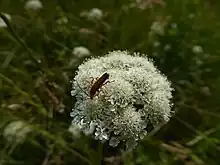
Distribution and status
.jpg.webp)
Corky-fruited water-dropwort is widely distributed in Europe, ranging from western Ireland and southern Britain to Turkey, then into western Asia including Israel, Jordon, Lebanon, and Syria. It also extends south through France, Spain, Portugal, and Morocco.[24]
In the UK, its natural range is restricted to a few counties such as Somerset, Dorset, and Hampshire; where it is locally common.[3] However, it may be naturalized elsewhere in the country, such as in Cambridgeshire. In 2006, several plants were discovered growing around fishermen’s platforms dug into the bank of a lake at RAF Waterbeach.[25] The following year, about a dozen plants were found growing in a naturalized state on a lawn around a small pond at the British Antarctic Headquarters at High Cross, Cambridge.[26]
A new Irish record for the species was made at Duncannon in County Wexford in 2006.[27]
Uses
The related species hemlock water-dropwort is highly poisonous, and it is often assumed that corky-fruited water-dropwort would be similarly dangerous,[28] but there is no record of it ever harming humans or livestock, and often occurs in hay meadows and pastures without any ill effect on cattle, sheep or horses.[29][1] In Turkey it is reported to be consumed by the locals after roasting or cooking with yoghurt and bulgur wheat[30] or pickled and cooked in the winter. It is said to be used as a digestive stimulant.[20]
References
- Preston, C.D.; Pearman, D.A.; Dines, T.D. (2002). New Atlas of the British and Irish Flora. Oxford: Oxford University Press.
- Poland J, Clements EJ. 2009. Vegetative Key to the British Flora. BSBI.
- Tutin TG. 1980. Umbellifers of the British Isles. BSBI Handbook No. 2. ISBN 0-9-0115802-X
- Streeter D, Hart-Davies C, Hardcastle A, Cole F, Harper L. 2009. Collins Flower Guide. Harper Collins ISBN 9-78-000718389-0
- Sell, Peter; Murrell, Gina (2009). Flora of Great Britain and Ireland, vol 3. Cambridge: Cambridge University Press.
- Southam M. 1996. Recurring problems in Oenanthe. BSBI News 71: 22 – 24.
- Rose F, Walls RM. Oenanthe, fined leaved species. In: Rich TCG, Jermy AC. 1998. Plant Crib. BSBI.
- Foley MJY, Southam MJ. 2007. Oenanthe incrassans Bory & Chaub. (Apiaceae), a distinctive plant of the Aegean region. Candollea 62(2). ISSN: 0373-2967.
- Güner ED. 2016. Oenanthe incrassans: an enigmatic species from Turkey and its comparison with Oenanthe pimpinelloides (Apiaceae). Phytokeys 62: 101 – 111. doi: 10.3897/phytokeys.62.8106
- Constance, L. (1971). History of the classification of Umbelliferae (Apiaceae) in Heywood, V. H. (ed.) The Biology and Chemistry of the Umbelliferae. London: Academic Press. pp. 1–11.
- Hassler, M. "Synonymic Checklists of the Vascular Plants of the World".
- Global Biodiversity Information Facility. "Oenanthe pimpinelloides subsp. incrassans".
- Global Biodiversity Information Facility. "Oenanthe pimpinelloides subsp. callosa".
- Global Biodiversity Information Facility. "Oenanthe pimpinelloides subsp. pimpinelloides".
- Stace, C.A. (2019). New Flora of the British Isles. Suffolk. ISBN 978-1-5272-2630-2.
{{cite book}}: CS1 maint: location missing publisher (link) - Wiktionary. "dropwort".
- Radutoiu D, Stan I, Costache I. 2014. Oenanthe pimpinelloides L. in the flora of Romania. Contribuţii Botanice 49: 61 – 66.
- Rodwell, J.S. (1991–2000). British Plant Communities, vols. 1-5. Cambridge: Cambridge University Press.
- Fois, M. "Discovering neglected vegetation in Sardinia: from knowledge to conservation". UNICA IRIS Institutional Research Information System. Retrieved 25 December 2022.
- Arslanoglu, S.F. (2016). "Some medicinal plants gathered from natural areas". Lucrări Ştiinţifice. 59 (2).
- Hill, M.O.; Mountford, J.O.; Roy, D.B.; Bunce, R.G.H. (1999). Ellenberg's indicator values for British plants. ECOFACT Volume 2. Technical Annex (PDF). Institute of Terrestrial Ecology. ISBN 1870393481. Retrieved 29 May 2017.
- Biological Records Centre. "Insects and their food plants". Retrieved 23 December 2022.
- McKenzie H, Davenhill N, Gifford H, Hawke A. 1998. Growth of Eucalyptus nitens after application of herbicide to control parsley dropwort. Proceedings of the New Zealand Plant Protection Conference 51: 241 – 244.
- Cook CDK. 1968. Oenanthe. In: Tutin et. al. (eds.). Flora Europaea. Cambridge University Press, Cambridge, 2: 338-339.
- Leslie A. 2007. Vascular Plant Records. Nature in Cambridgeshire 49: 89 – 95.
- Cadbury CJ. 2010. Water dropwort Oenanthe species in Cambridgeshire. Nature in Cambridgeshire, No. 52.
- Green PR. 2008. Oenanthe pimpinelloides (corky fruited water dropwort) found at Duncannon, New for County Wexford (V.C. H12). Irish Botanical News 18: p31.
- Plantwild. Available at [[Corky-fruited water-dropwort (Oenanthe pimpinelloides) plants (plantwild.co.uk)] (Accessed 16/07/2022)
- Cooper, M.R.; Johnson, A.W.; Dauncey, E.A. (2003). Poisonous Plants and Fungi. London: The Stationery Office. ISBN 0-11-702861-4.
- Ozbek K, Karabak S, Aysar N, Guzelsoy NA, Nurgal SARI, Duran RM, Tasci R, Guner B, Yucearslan H, Deniz D, Aksoy A. 2017. Biodiversity for food and nutrition project: Black Sea region studies ANADOLU Ege Tarımsal Araştırma Enstitüsü Dergisi 27(2): 17 - 25.
